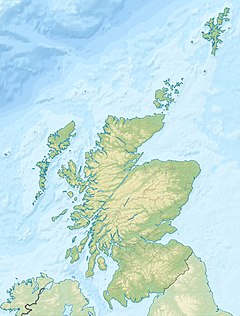Cape Wrath
| Cape Wrath Scottish Gaelic: Am Parbh |
|
|---|---|

Cape Wrath from the sea
|
|
|
|
|
| Coordinates | 58°37′29″N 5°00′05″W / 58.6248°N 5.0015°WCoordinates: 58°37′29″N 5°00′05″W / 58.6248°N 5.0015°W |
Cape Wrath (Gaelic: Am Parbh, known as An Carbh in Lewis) is a cape in the Durness parish of the county of Sutherland in the Highlands of Scotland. It is the most north-westerly point in mainland Britain.
The cape is separated from the rest of the mainland by the Kyle of Durness and consists of 107 square miles (280 km2) of moorland wilderness known as the Parph. The first road in the district was built in 1828 by the lighthouse commission across the Parph. This road is only accessible via the passenger ferry that crosses the Kyle of Durness.
Much of the cape is owned by the Ministry of Defence and is used as a military training area, including as live firing range. Areas of it are also designated as a Site of Special Scientific Interest, a Special Protection Area, a Special Area of Conservation and a Special Landscape Area.
The name Cape Wrath is derived from Old Norse hvarf ("turning point"). In this context "Wrath" is pronounced /ˈræθ/ (to rhyme with "math"), in contrast to the ordinary English word "", usually pronounced /ˈrɒθ/ in British English (to rhyme with "Goth"). Vikings are believed to have used the cape as a navigation point where they would turn their ships.
...
Wikipedia

